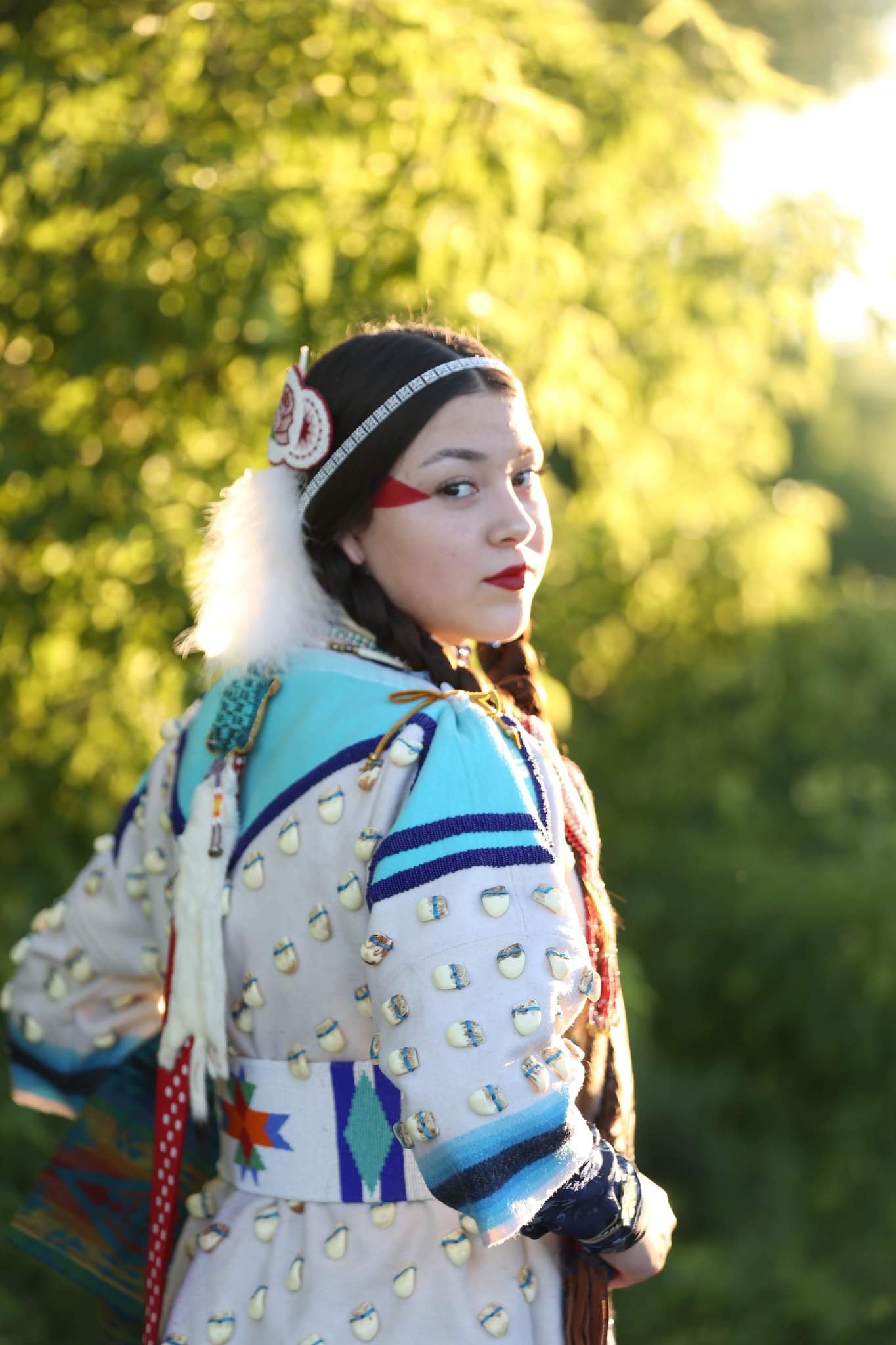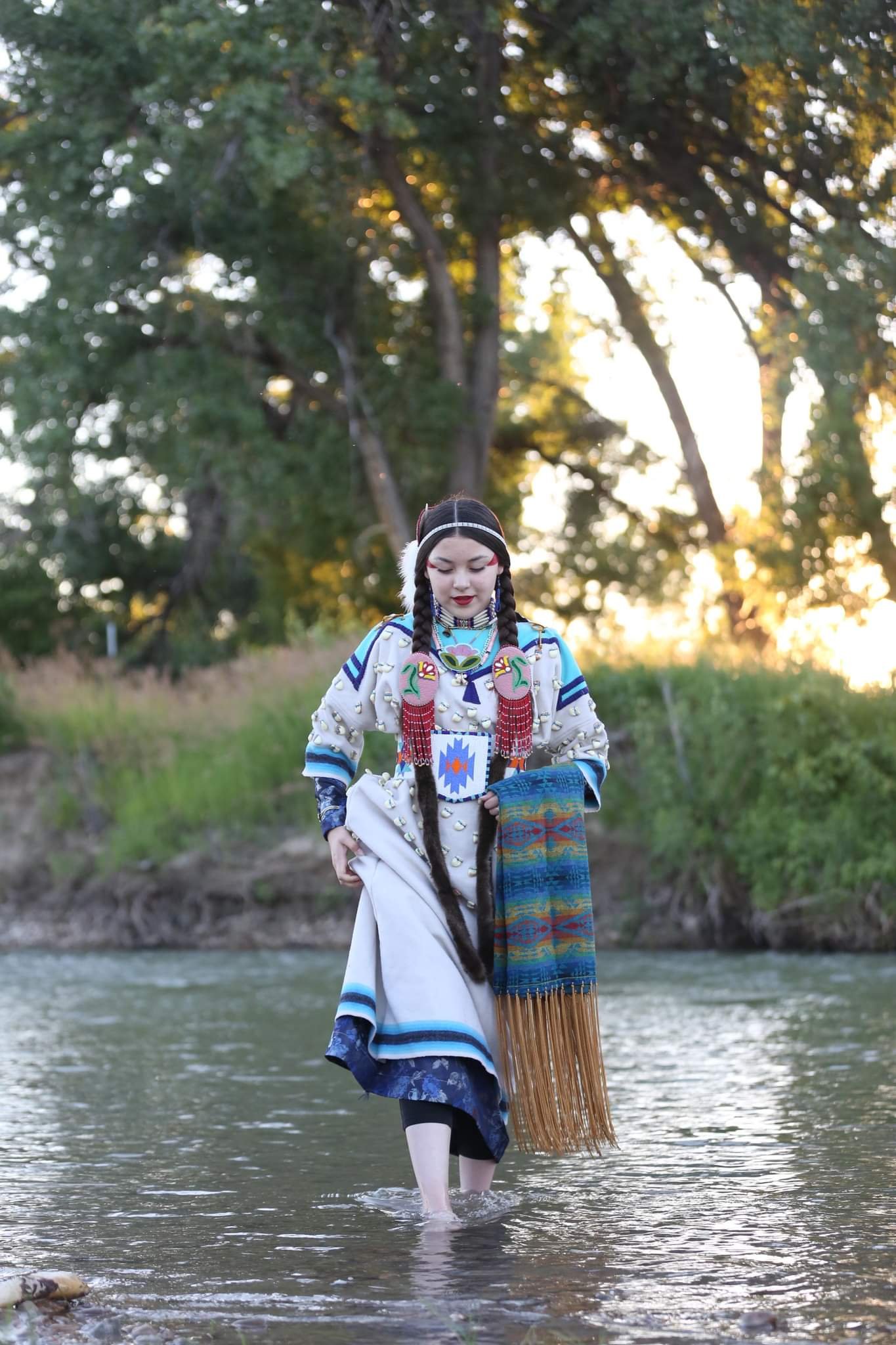Care
Meditating on the care we take of, and have for, one another can inspire incredible beauty. The works here are a testament to the care these artists have for their families and communities. Their making was an act of care itself.
Gifting, in particular, is a way these artists have shown care through their work. Luella Brien created The Dress That Showtime Bought as a labor of love for her daughter. Dulcie BearDon’tWalk beaded her son’s belt as a gift for his wedding, and Jordyn Hrenyk beaded her gift circles as emblems of gratitude for her mentors. Other works express care through their content or the ideas that inspired them. Burlington Tooshkenig designed the lid of his basket while thinking about the community of Bead Night and how they care for one another as artists and people. Meanwhile, Awanigiizhik’s work Ginanaakonaamin SARS-CoV-2 features spirits that provide guidance and healing to Anishinaabe people in difficult times. Each artwork in this section is an expression of care from the artist who made it.
Jacob’s Moccasins
Crystal Lepscier
Little Shell Chippewa, Menominee, and Stockbridge-Munsee
2018
Leather, sinew, velvet, beads, thread, and ribbon
These little child moccasins were made for my son's first trip around the Woodland Bowl in the Menominee community. Jacob along with seven other children were being recognized for their little parts in the Menominee language immersion daycare classrooms. The grouping of children were the first 8 to ever be a part of this monumental language revitalization effort, one of the various projects in this area of sovereignty and reclamation. I made his moccasins for him to wear on this day, and used primary colors which are common in early Menominee and woodland floral designs. The shapes are reminiscent of young plants, leaves which will grow with time, much like my son's language journey has grown. He was about one year old when he walked around for that honor song at the Menominee powwow, and these moccasins show his little toes marked on the bottom.

Three Gift Circles
Michif
2020
seed beads, thread
In these works, Hrenyk placed one bead after another, varying her colors, to create three mesmerizing circles. She made these beaded circles as gifts for three professors who devoted extensive time and energy to supporting her through the comprehensive exams phase of her Ph.D. program.
She has made similar circles as part of research projects and sees this beading as a process for uncovering key teachings in stories that are shared with her. In research, this process is sometimes called a “conceptual leap” by scholars Malvina Klag and Ann Langley. As she beads each circle, she holds certain ideas and people in mind, and, in so doing, engages in meditation and reflection on the full teachings and stories. She seeks to access what Tewa author and professor Gregory A. Cajete calls the ‘metaphoric mind’. Tapping into one’s metaphoric mind is one way of accessing a kind of Indigenous knowledge that Mohawk Professor Brant Castellano calls the knowledge of revelation. Revelation, or revealed knowledge, is “acquired through dreams, visions, and intuitions that are understood to be spiritual in origin.” When Hrenyk beads these circles, she tries to listen to the original stories and their storyteller and bring together disparate threads and ideas to make sense of what they have shared.
“Each of these three completed circles has a personal story attached to them that I shared directly with each mentor that I worked with to complete my comprehensive exams, “ Hrenyk explains.
“The first piece is about Indigenous Knowledges and how we as Indigenous Peoples have had our knowledge systems disrupted, but how bringing youth and Elders together with the land can help us to reclaim and recenter our ways of knowing again. The second piece is about a journey to self-discovery and more fully understanding one’s place in the world. The final piece is about ideas of home and holding onto memories of home even through periods of oppression; it is about how different Peoples can come together to create a shared home even after colonization has tried to drive them apart.
The stories all begin with the centre bead and radiate outwards; this follows from the work of Indigenous studies scholar Joanne Archibald who specifies “the importance of beginning the learning with the ‘core’ of knowledge and starting from the inside before going to the surface, the outside” when working with Indigenous stories. Each piece holds deep meaning for me and I hope for the mentors to whom I gifted them. However, I invite viewers to draw their own ideas and teachings from the beads, as the beads and the stories are the teachers here; I hope you find the teachings and the stories you need from them.”


Cool, blue wool descends downward from the top of the dress forming a “W” pattern across the chest and back as it meets cream wool. Apsáalooke (Crow) historically use red, navy, and green wool to make elk-tooth dresses, but Brien sought out unique materials like this cool, blue wool. In the Apsáalooke community, elk-tooth dresses historically represent that the wearer is well taken care of because they have been fed the elk whose teeth adorn their dress. Today, imitation elk teeth, like those on this dress, are commonly used. But elk-tooth dresses continue to represent that the wearer is well taken care of by their family. The approximately 350 elk teeth and other materials used to construct this dress were purchased by the Showtime Network, which planned to film Brien making the dress as part of a documentary project. Brien rightly calls this “the dress that showtime bought.”
2022
Limited Edition Fire and Water Teton Trade cloth, painted imitation elk teeth, blue imitation sinew, flannel, and blue cut beads
Beaded Belt
Turtle Mountain, Crow, Assiniboine, Lac Courte Oreilles Ojibwa & White Earth Ojibwa
leather, seed beads, thread
BearDon’tWalk made this beaded belt for her stepson’s wedding. She incorporated Apsáalooke (Crow) traditional geometric designs using his wedding colors. The project was a labor of love and a collaboration with her husband, who designed the belt’s buckle with images significant to their son’s Danish background. Fusing together Crow designs in the beadwork and Norse designs in the buckle, the belt represents their son’s roots. BearDon’tWalk beaded a corresponding hat for her stepson’s bride-to-be and remembers gifting the belt and hat to the couple: “The morning of their wedding we went outside and prayed for them at sunrise and gave them their gifts. We were able to spend time with them, just the two of us, and give them the gifts that we wanted to give them from the heart.” He wore this belt on his wedding day.
All Things Familiar to Me
Walpole Island First Nation
2022
Sweetgrass, porcupine quill, birch bark, polyester thread
Width at the bottom of the basket is 7 inches. Width at the top is 10 inches. Height is 5.5 inches
An intricate layering of quills form a ruby-throated hummingbird at the center of this sweetgrass basket lid. Quilled on birchbark, the ruby-throated hummingbird is surrounded by lush plants and vines. Each of the plants represented on this sweetgrass basket lid are familiar to Tooshkenig. Starting clockwise and moving around the basket are wild grapes, lillies of the valley, wild strawberries, wild mallow, Black-Eyed Susans, and day or “ditch” Lillies as Tooshkenig calls them. Before designing the quilled birchbark lid, he designed the bowl of the sweetgrass basket. The bowl slants upward as the top of the basket widens and features an indentation to accommodate the fitted lid. Tooshkenig used sweetgrass gathered from three different years and blended them together to form the walls of the basket. The outside wall of the basket features one, long braid of sweetgrass woven into a 3-leaf Anishinaabek design. Tooshkenig estimates that the basket took over 60 hours to make, not including the time to prepare materials.






Ginanaakonaamin SARS-CoV-2
We (inclusive) are fighting back against SARS-CoV-2
2020
seed beads, thread, microcontroller programmed LED lights, watercolor,
12” x 12” x 3”
Turtle Mountain Chippewa
Animikii (thunderbird) and Mishiipishiw (water panther) are some of the most powerful spirits under Kizhe-Manidoo (Creator). They represent synergistic, diametric force which is exemplified in Anishinaabe spirituality. These spirits are akin to the qualities of water. The water from the skies to underneath the earth. Water is synonymous with life. These spirits are who we look to for guidance and healing with the most pressing issues. In the past, these spirits were petitioned to ask from the Creator to heal us from smallpox and many other deadly diseases. In this case, we are fighting the Coronavirus pandemic. Within this art piece, these spirits are coordinated in attacking the coronavirus. This theme personifies our carefulness, strategies, and prayers working to overcome these uncertain times.
The beadwork area consists of: 15/0s miyuki beads, 13/0s charlotte beads, 12/0s and 9/0s tri-cut beads. 12/0s tricut 24 karat gold and 13/0s miyuki galvanized copper beads are utilized. Underneath the beadwork inserted panel are electronics. The microcontroller programmed LEDs give animation, time, interactions, and life to the storytelling. The layered watercolour background is reminiscent of the hydrous powers and connections of these two spirits. The details within the watercolour patterns stylize turbulent forces found within nature. Awanigiizhik Bruce developed this new form of beadwork. Awanigiizhik combined elements of raised beadwork, lane stitch, and 3D beadwork to create a new style. Awanigiizhik calls this style the Wajiw (mountain) stitch or style of beadworking. In order to replicate this style, you will need to build a topographical under-structure as your base, while using wire, thread, and beads to build mountainous, simulated, three-dimensional forms.



